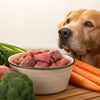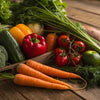How to Calculate How Much Raw Food to Feed Your Dog: A Comprehensive Guide
- Houndsy
Table of Contents
- Introduction
- Understanding Your Dog's Nutritional Needs
- Methods for Calculating Raw Food Intake
- Practical Example of Calculation
- Creating a Feeding Schedule
- Preparing Raw Meals
- The Benefits of Raw Feeding
- Conclusion
Introduction
Did you know that the ideal raw food intake for dogs can vary significantly based on numerous factors, including weight, age, breed, and activity level? If you're one of the many dog owners contemplating a switch to a raw food diet, you might be wondering how to accurately determine the right amount to feed your furry friend. This topic is crucial for ensuring not only your dog’s health and well-being but also for easing the feeding routine, which we at Houndsy know is important for busy pet owners.
In this blog post, we’re going to delve deep into the methods for calculating how much raw food to feed your dog. We will cover various factors that influence your dog's dietary requirements, different calculation methods, and how to adjust these amounts to suit your individual dog. By the end of our discussion, you will have a comprehensive understanding of how to tailor a raw feeding regimen that fits your dog’s unique needs.
As we navigate through these topics, we encourage you to reflect on your own pet feeding routines. Are you currently meeting your dog’s nutritional needs? Let’s explore together!
Understanding Your Dog's Nutritional Needs
Before we get into the calculations, we must first look at the underlying factors that drive your dog’s nutritional requirements. Understanding these factors is essential to crafting an optimal feeding plan.
Age
Age plays a fundamental role in determining how much food a dog needs. Puppies, for instance, are growing rapidly and need more calories than adult dogs. Generally, they require about 4-6% of their current weight in food daily, compared to adult dogs, who typically need 2-3%.
Weight and Ideal Weight
The current weight of your dog is the first metric to consider. However, equally important is your dog’s ideal weight, which is the weight that ensures their optimal health. You may need to adjust the amount based on whether your dog is underweight or overweight.
Activity Level
The more active your dog is, the more calories they’ll require. If your dog participates in vigorous exercise regularly, consider increasing their food portion within the recommended percentage range. Conversely, less active dogs may require less.
Breed
Different breeds have different energy expenditures and metabolic rates. For example, working dogs often need more food than lap dogs due to their higher energy demands. Understanding your dog's breed can guide you in determining the right feeding strategy.
Health Conditions
Always consult your veterinarian when deciding how much to feed, especially if your dog has any health conditions that could impact their nutritional needs. Some conditions may require specific diets, and your vet can help tailor a raw feeding plan that fits.
Methods for Calculating Raw Food Intake
Now that we understand the critical factors affecting your dog's nutritional needs let’s dive into the methods for calculating how much raw food to feed them.
Maintenance Percentages
One common way to calculate the amount of food your dog needs is using a maintenance percentage based on their ideal body weight. Here’s how it works:
- For Adult Dogs: Feed 2-3% of their ideal body weight daily.
- For Puppies: Feed 4-6% of their current weight.
For example, if you have a 50-pound adult dog, you would multiply their weight by 0.03 (the higher end of the maintenance percentage range) to get the amount of food in pounds:
- 50 lbs × 0.03 = 1.5 lbs of raw food per day.
You can similarly calculate for puppies. For instance, if you have a 15-pound puppy:
- 15 lbs × 0.05 (using the middle ground of 4-6%) = 0.75 lbs of raw food per day.
Activity Level Adjustments
Once you have a base calculation, you should adjust based on your dog’s activity level. Active dogs should receive higher portions—consider adding another 10-20% to the daily intake based on their routine. For instance, using the previous example of a 50-pound dog:
- Yard work or playtime could justify an increase, leading instead to 1.65 lbs for the more active dog (1.5 lbs + 0.15 lbs).
Monitoring Weight
Weight monitoring is vital when determining the right feeding level. If your dog is gaining or losing weight when you’ve followed your calculated example, you may need to adjust accordingly:
- Weight Loss: If your dog loses more than 1-2% of their weight weekly during the transition to raw, consider slightly increasing their portions.
- Weight Gain: If your dog is gaining weight, reduce their portions as needed.
Practical Example of Calculation
Let’s walk through a real-world example to illustrate these calculations in action.
Imagine we have a one-year-old Labrador weighing 80 pounds, and we discover their ideal weight is around 70 pounds because they are slightly overweight.
- Choosing the Percentage: We decide to use the middle range of 2.5% for a general guide.
-
Calculating Daily Intake:
- 70 lbs × 0.025 = 1.75 lbs of raw food daily.
-
Activity Adjustment: Suppose the Labrador enjoys an active lifestyle; we’ll add 15% to that base:
- Increase = 1.75 lbs × 0.15 = 0.2625 lbs.
- Total = 1.75 lbs + 0.2625 lbs = approximately 2 lbs of food daily.
By monitoring weight weekly, we can further adjust portions, reinforcing the importance of being meticulous about any fluctuations.
Creating a Feeding Schedule
Feeding routines can profoundly affect your dog’s digestive health. Structuring a consistent feeding schedule aids not just in creating predictability but also promotes better digestion:
- Puppies: Feed them 3-4 times a day until six months old. After that, you can transition to 2-3 times a day.
- Adult Dogs: Stick to consistently feeding planned meals twice a day, allowing a balanced distribution of nutrients while preventing bloat.
Sample Feeding Schedule
- Morning: 50% of daily intake
- Evening: 50% of daily intake
Engaging in this routine will help lower the risk of obesity and ensure repeated success in your raw feeding efforts.
Preparing Raw Meals
The next step in feeding your dog raw food pertains to meal preparation. When feeding raw, consider the following:
Balance Nutrients
Raw feeding requires careful attention to balance. Consider different types of meat (beef, chicken, lamb, turkey) and other food sources like organ meats, bones, and vegetables to formulate a holistic diet.
Keep It Fresh
Ensuring the freshness of the food is crucial for your dog’s health. Store raw food in the Houndsy Kibble Dispenser, which is designed for functionality and maintaining food quality.
Portion Control
Ensure you are accurately measuring the food portions using a kitchen scale. This helps maintain consistency in your feeding routine, which is essential for proper nutrition.
The Benefits of Raw Feeding
Besides improving nutritional health, raw feeding presents additional benefits:
- Shinier Coat: Raw diets typically lead to improved skin and coat health.
- Enhanced Dental Health: Chewing raw food can help reduce plaque and tartar build-up.
- Increased Energy: Many pet owners report enhanced energy levels in their dogs.
As with all dietary changes, transition slowly over a week or two to avoid gastrointestinal upheaval. Replace a percentage of their existing food with raw, gradually increasing the raw content until they are fully on the new diet.
Conclusion
Navigating the shift to a raw food diet doesn't have to be daunting! By keeping a keen eye on your dog's age, weight, activity level, and overall health, you can develop an effective feeding strategy that fits your dog perfectly.
Continuous monitoring is key, as each dog can respond differently to dietary changes. You'll refine your calculations over time, ensuring your dog gets the best nutrition possible.
Now that you understand how to calculate how much raw food to feed your dog, why not make meal prep an even smoother experience? Check out the Houndsy Kibble Dispenser, designed to simplify your feeding routine by offering perfect portion control and a sleek, modern design to fit your home decor. Order Now and elevate your feeding experience today!
FAQ
How often should I feed my dog raw food?
Most adult dogs typically benefit from being fed twice daily. Puppies may require more frequent feedings.
Can I mix raw food with dry food?
It’s best to transition to raw food solely rather than mixing it with dry foods to avoid digestive issues.
How long can I store raw meat in the refrigerator?
Raw meat can generally be stored in the refrigerator for about 1-2 days. For longer storage, consider freezing portions in advance.
What if my dog won’t eat raw food?
It may take time for your dog to adjust. Try warming the food slightly or mixing it with a small amount of their current food.
Do I need to add supplements to the raw diet?
A raw diet can be very nutritious, but in some cases, you may need to supplement with vitamins or minerals. Consult with your veterinarian for personal recommendations.
With the right approach and Houndsy's innovative tools, we can make raw feeding a delightful experience for both pets and their owners. Let's make their mealtime not just necessary, but enjoyable!












